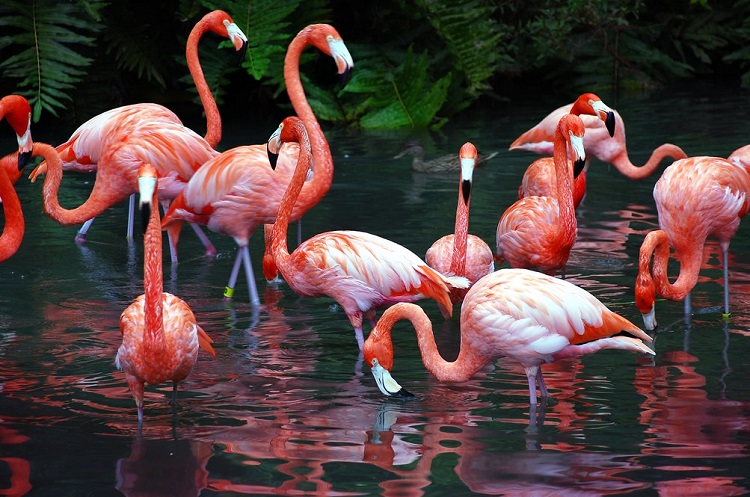Flamingos are truly striking creatures! With their bright pink plumage, long, slender limbs, and elegant curved necks, these colorful birds are a sight to behold. They even spend most of their day standing on one leg!
Despite their vibrant appearance, flamingos live in sparse habitats, but they are perfectly adapted to thrive in these conditions. Their unique biology and physical attributes enable them to survive where most animals cannot. Pretty awesome, right?
Hungry to learn more about fancy flamingos? Well, you’re in the right place! Today I’m going to tell you everything you ever wanted to know about these sassy water birds. Read on to become an official flamingo expert among your friends!
Taxonomy
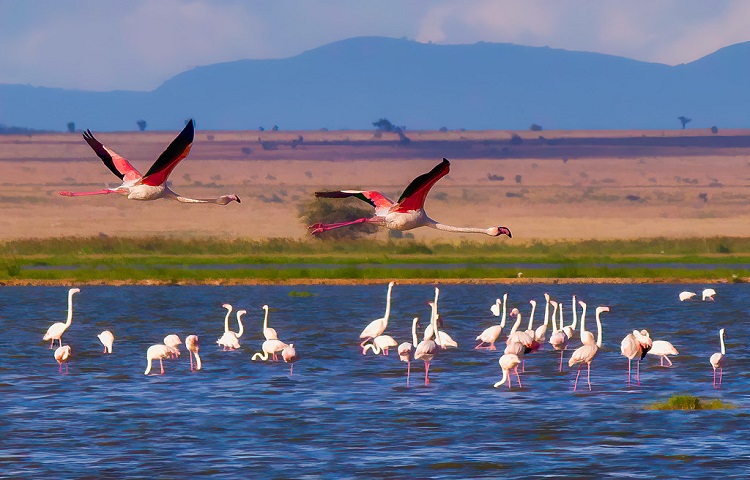
- Kingdom: | Animalia
- Phylum: | Chordata
- Class: | Aves
- Order: | Phoenicopteriformes
- Family: | Phoenicopteridae
Flamingo Species
There are six flamingo species. Of these six species, two are native to Africa, Europe, and Asia, and the other four species are found across the Americas.
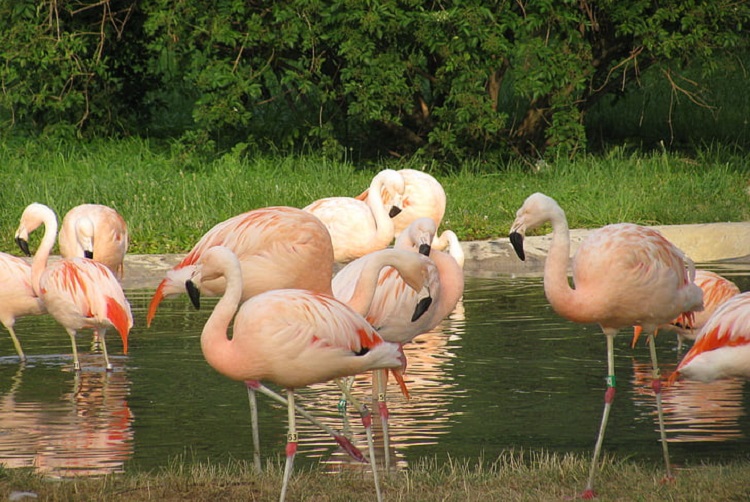
- The Greater Flamingo (Phoenicopterus roseus) is the most widespread species. It is found across the Middle East, the Indian continent, Africa and Southern Europe.
- Lesser Flamingos (Phoeniconaias minor) are found in Sub-Saharan Africa and Western India.
- Chilean Flamingos (Phoenicopterus chilensis) are found across South America, including Chile, Paraguay, Peru, Bolivia, and Argentina.
- Andean Flamingo (Phoenicoparrus andinus) is native to the Andean mountains and are the rarest flamingos. They are threatened by local mining and are now considered vulnerable.
- Caribbean Flamingo (Phoenicopterus ruber) is present in South America, several Caribbean Islands, Mexico, and Florida. They are sometimes called American flamingos.
- James’s Flamingo (Phoenicoparrus jamesi) lives in high-altitude regions of Peru, Bolivia, Chile, and Argentina.
Relationship with Grebes
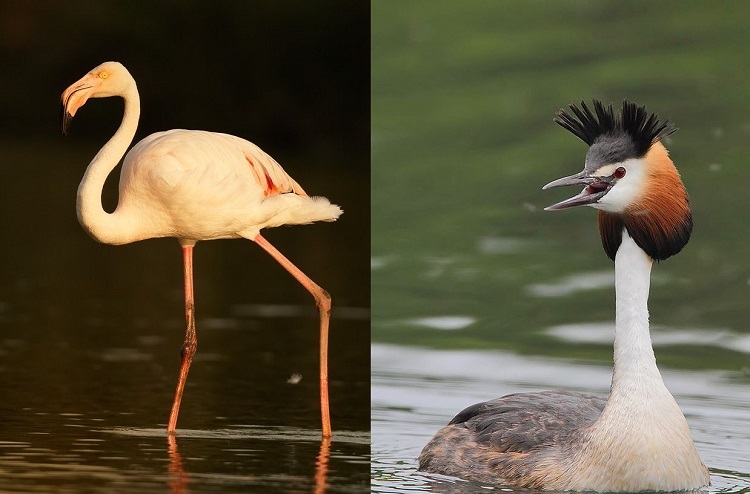
Some recent research has found a strong genetic link between flamingos and grebes. Not only do these two water birds have several unique physical similarities, but they also share DNA molecules, too.
All of this suggests that flamingos and grebes are closely related, even though they look very different at first glance!
What Do Flamingos Look Like?
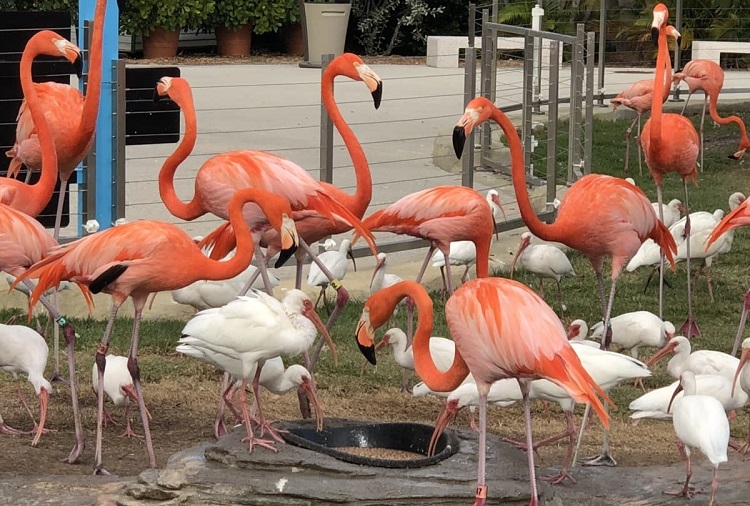
Of course, the most striking feature of a flamingo is its bright pink or reddish coloration.
Flamingos vary in tone from pale, light pink, to a deep crimson red, depending on the particular species. The intensity of their coloring is linked to their diet, but more on that later!
Flamingos are also known for their long, skinny legs that enable them to wade through deep waters. It’s very common to see these bright birds standing on one leg when taking a rest.
Flamingos have very slender, flexible necks that are curved in an S-shape. Their bills are very hooked so that they can sift through the water to capture their food.
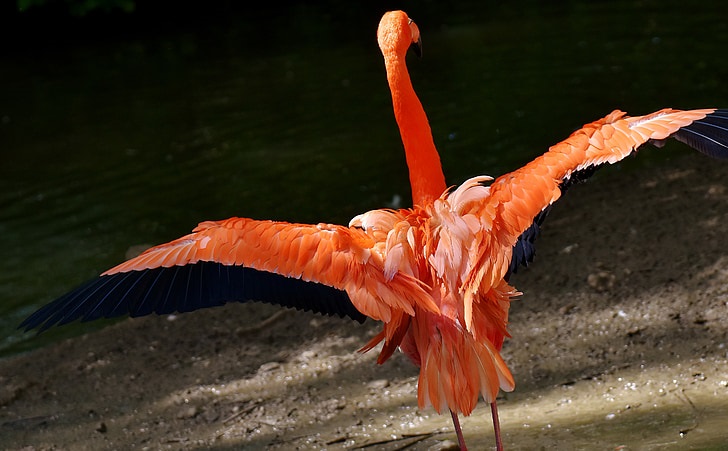
Each type of flamingo looks slightly different, but they all have these main traits in common.
The largest flamingo is the Greater Flamingo, which also happens to be the most common species. Greater flamingos stand up to 4.7 feet tall and can weigh up to 9 pounds.
The smallest flamingo species is the Lesser Flamingo. This beautiful bird reaches up to 2.9 feet tall and weighs between 3.3 to 4 pounds.
Flamingo Facts

- It may look like a backward knee joint, but the bend in a flamingo’s leg is actually its ankle! Their knees are much higher up their legs, hidden amongst thick feathers.
- Flamingos can swim! These striking birds are very good swimmers, although they tend to hang out in shallow water, so it’s something they rarely need to do.
- Flamingos are pretty fast. They can fly up to 35 miles an hour and often travel long distances between food sources. They can look quite funny with their long legs dangling behind them!
Flamingo Habitat
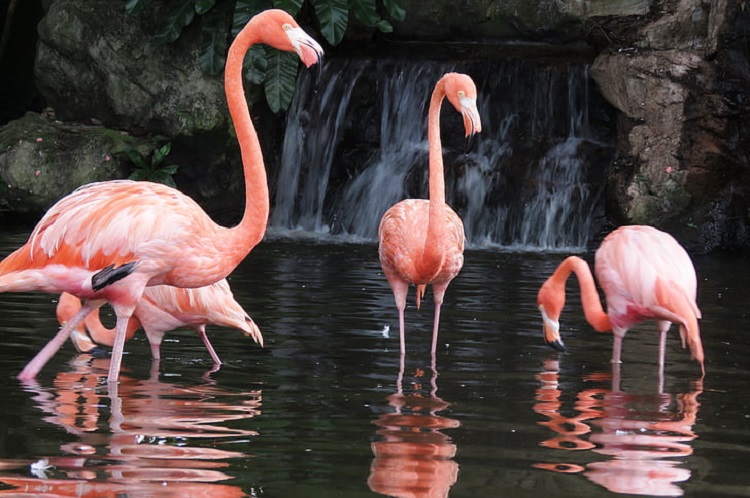
Flamingos prefer to live around large, shallow lakes and lagoons. As they are shallow, these aquatic habitats are often salty, which makes them unappealing to other creatures. Often, flamingos are the only animal to frequent these pools, aside from the tiny crustaceans, algae, and diatoms that they feed upon.
Behavior
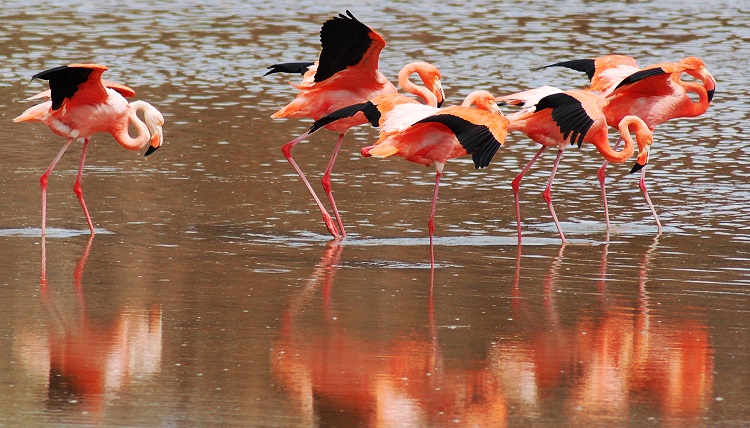
These brightly-colored animals are very social birds. They love to hang out in large colonies, sometimes called “flamboyances”, which can contain tens of thousands of individuals! When they are all gathered together, the shock of bright pink feathers against the surrounding landscape is quite an impressive sight!
It’s thought that flamingos come together in large groups as a way to help them avoid predators. After all, they do tend to stand out, so safety in numbers can’t be a bad idea.
Flamingos have a variety of vocalizations, including nasal honking, babbling, and growling, to communicate with others in their colony.
Diet
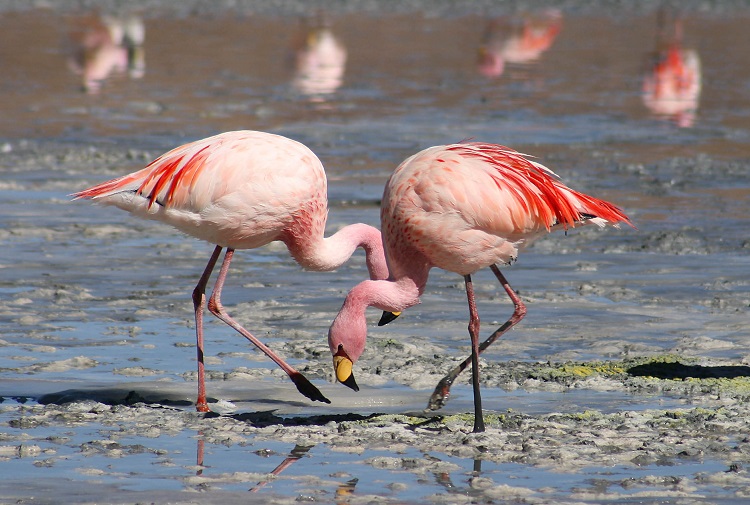
Flamingos eat minuscule blue-green algae and very small crustaceans. Because they live in salty environments, there often aren’t any other animals living there, so they have the food source all to themselves.
These birds are filter-feeders. They bend their long necks, hold their big curved bills upside down, and suck in a mouthful of water and mud. They then spit it out of the sides of their bill, pumping it through a built-in “filter” to trap shrimp and other little crustaceans. This filter is made of briny plates and is called lamellae.
Reproduction and Lifespan
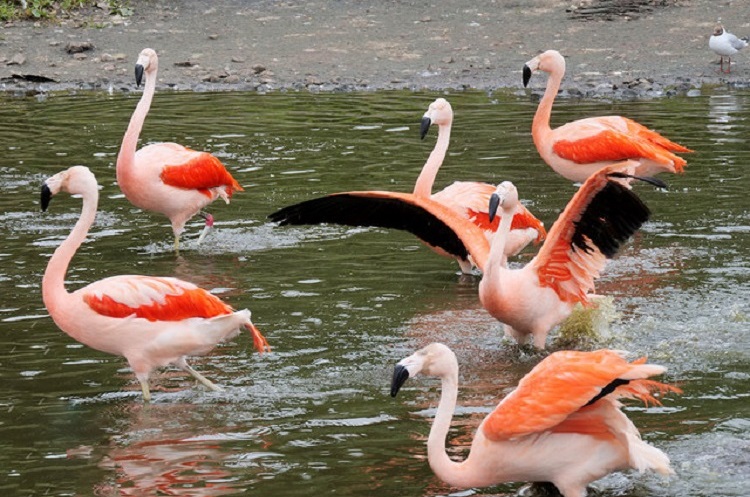
Flamingo colonies take part in ritual displays that stimulate the hormones needed for breeding. In a group, the majority of adult flamingos will breed, unless they are sick or injured.
The process of courtship is fairly laid-back. A female flamingo chooses her preferred male, who will then follow her around faithfully. Flamingo pairs will stay together so long as she conceives, but if she doesn’t, she will choose someone else and try again.
A female flamingo generally lays a single, large egg in a concave nest made from a mound of mud. The nest is built high enough above the ground and has a trench around it to keep the egg safe from flooding or high temperatures. The male and female build and maintain the nest together.
When the flamingo chick hatches, it isn’t pink. Instead, it has gray feathers and is around the same size as a tennis ball. At first, the baby has a straight, light pink bill and pink legs. These both turn black after about a week, mimicking the adults.
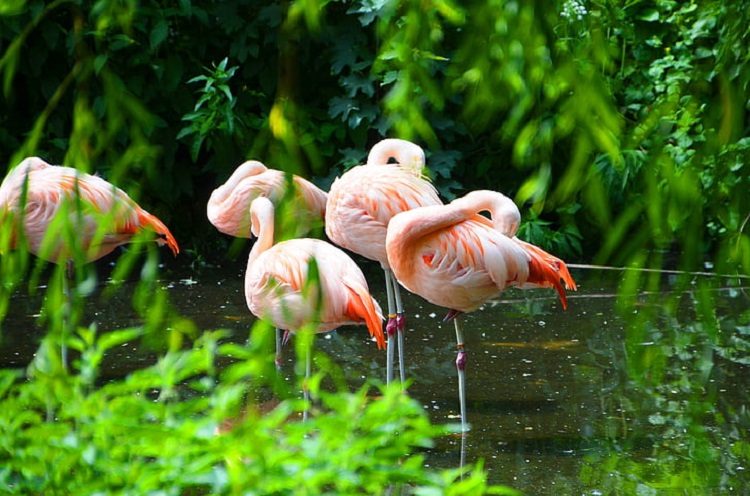
Flamingo chicks will stay close to the nest for the first couple of weeks. Both parents feed the chick with crop milk, which is stimulated by its hungry calls. The mother and father flamingos are so dedicated to feeding, that they lose their color and become pale pink or white. When the flamingo chick is able to feed independently, the parents get their color back again.
Flamingos can live between 20 to 30 years in the wild but can reach more than 50 years old in captivity.
Why Do Flamingos Stand on One Leg?
The reason why flamingos stand on one leg has been a mystery for decades. Scientists still don’t know for sure, but it is possible that using one leg reduces muscle fatigue. This means a flamingo can move faster should a predator turn up.
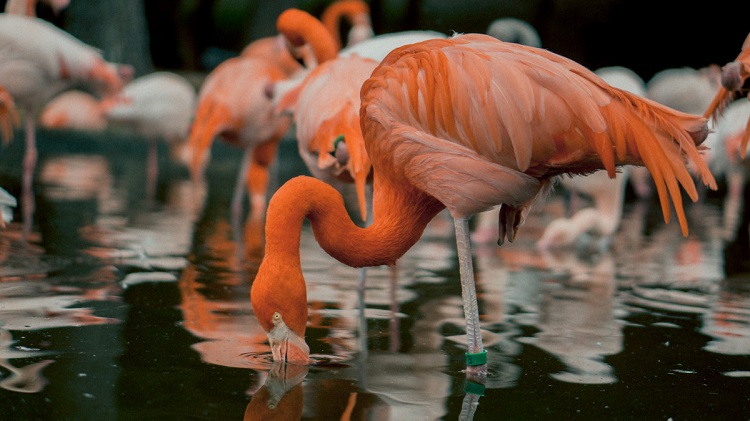
Other experts have theorized that it helps the flamingo maintain its body temperature. Lots of heat is lost through their bare legs, especially as they are often standing in water. By only standing on one leg, they lose half the amount of body heat that they usually would.
Both of these theories have been tested by observing flamingos in captive environments.
First of all, to test the muscle fatigue theory, researchers watched to see how quickly the individuals were able to move from a two-legged position and a one-legged position. Strangely, the flamingos were able to move faster if they started with both feet on the floor.
To test the heat theory, weather conditions, and body heat were monitored as the flamingos rested. As the weather became warmer, more individuals stood with both feet on the ground. As it got colder, they would usually stand on one leg.
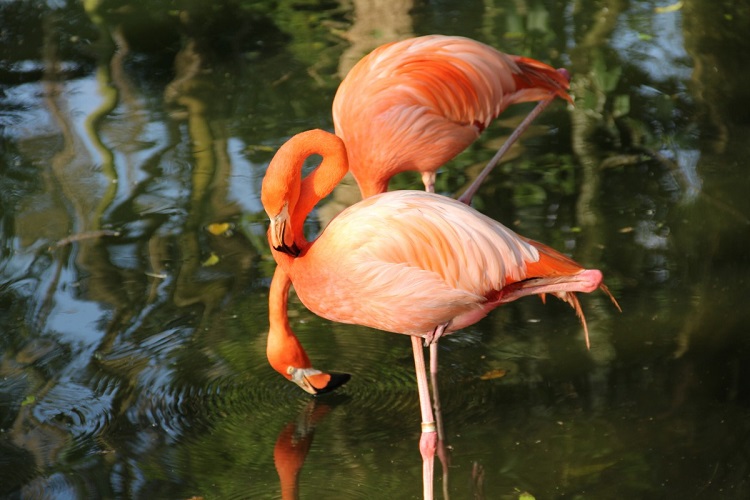
After these tests, it seems that the heat conservation theory is the most likely explanation. Although these birds live in tropical climates, standing in water can lower body temperatures fast. It makes a lot of sense to reduce the amount of skin in contact with water.
Some scientists believe that flamingos are also able to turn off half of their brains when they sleep. It could be that standing on one leg is a natural reaction to this phenomenon, and it helps to stop them from losing balance as they snooze.
So, why do flamingos stand on one leg? Nobody knows for sure! We have all kinds of theories, but for now, these sassy birds are keeping their secrets.
Why Are Flamingos Pink?
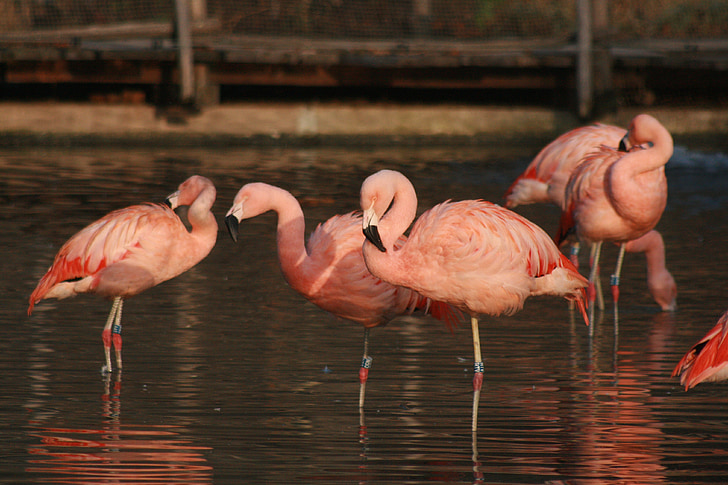
Flamingos get their pink color from their food! Algae, brine shrimp, and brine fly larvae contain high levels of the red-orange pigment beta-carotene.
When flamingos ingest these organisms, enzymes in their digestive system break down the beta-carotene. This compound is deconstructed into pigment particles that are absorbed by the liver and then deposited into their skin and feathers. When a flamingo sheds a feather, it rapidly loses its pink color.
Because flamingos eat such a large amount of beta-carotenoids, the colors come out through their skin and feathers. You don’t need to worry about changing color, though. You would have to eat an extraordinary amount of carotenoid-rich carrots before your skin would start to turn orange!
Predators and Threats
Because they live in such barren, salty habitats, flamingo adults don’t have many natural predators. But their chicks can be vulnerable to attacks from hawks and eagles.
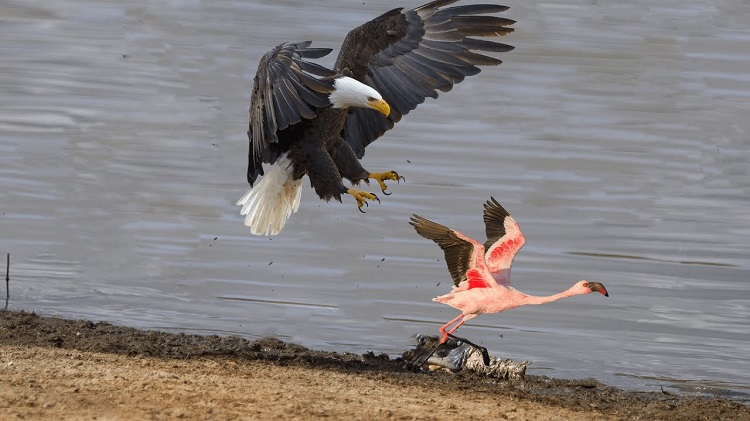
The most serious threat to flamingos is habitat destruction caused by humans. In the past, they were also hunted for use as food and medicine. Some indigenous people will still collect flamingo eggs.
In Mexico’s Yucatan Peninsula, around 100 Caribbean flamingos were killed by lead poisoning in 1989. This was the result of the ingestion of lead shot. After this incident, lead was banned in the region to prevent it from happening again.
Flamingos are also at risk from the effects of global warming. As the climate changes, rainfall rates in some regions are reducing. This can result in their lagoons drying out, destroying their habitat and breeding sites.
Conservation Status of Flamingos
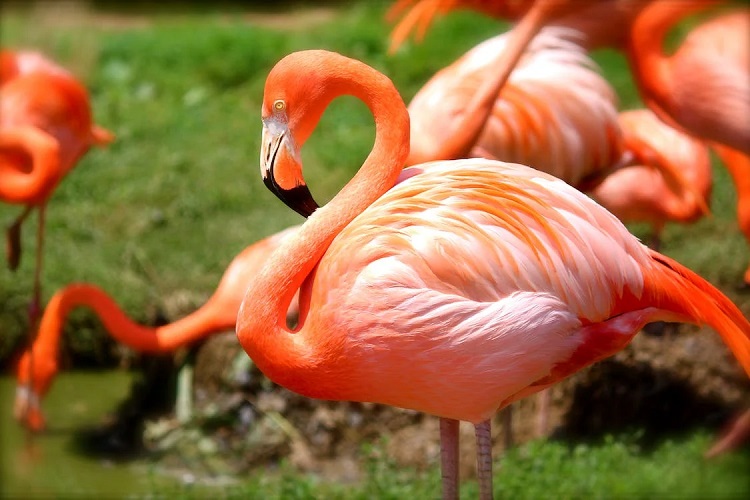
The IUCN has not designated any flamingo species as endangered, but the Chilean flamingo, Puna flamingo, and Lesser flamingo are recorded as “near threatened”.
The Andean flamingo is listed as “Vulnerable”. This is the rarest of all flamingos, and local conservation efforts are underway to help protect them. Chile has created a special flamingo reserve around one of its breeding lakes and is making plans to protect more flamingo lakes in the future.
The Flamingo Specialist Group was established in 1978. This group works to research, monitor and protect flamingo populations around the world. They also work in collaboration with IUCN to conduct surveys of wild flamingos and develop conservation strategies.
Flamingos in Ancient Cuisine
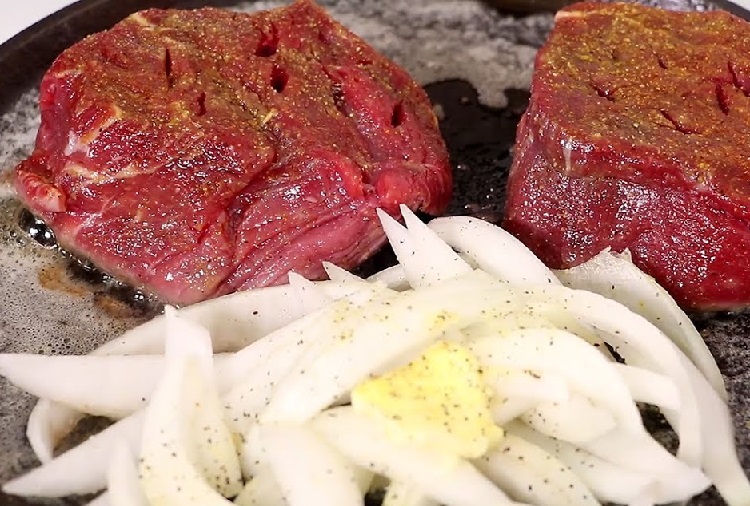
Ancient Romans used to eat all sorts of birds, but flamingo was seen as the most decadent and valuable dish.
Flamingo was eaten only by the wealthiest, as few people could afford them. Flamingo tongues were a particular delicacy. It has been described by Pliny the Elder as having the “most exquisite flavor”.
Flamingo meat was sometimes called “scarlet wing”. It was usually eaten roasted or boiled with a mixture of ground herbs and spices spread over the skin.
Flamingos’ Relationship with Human Beings
Flamingos are laid-back and calm-natured creatures. They are not aggressive animals, and they will not harm people unless they feel threatened.
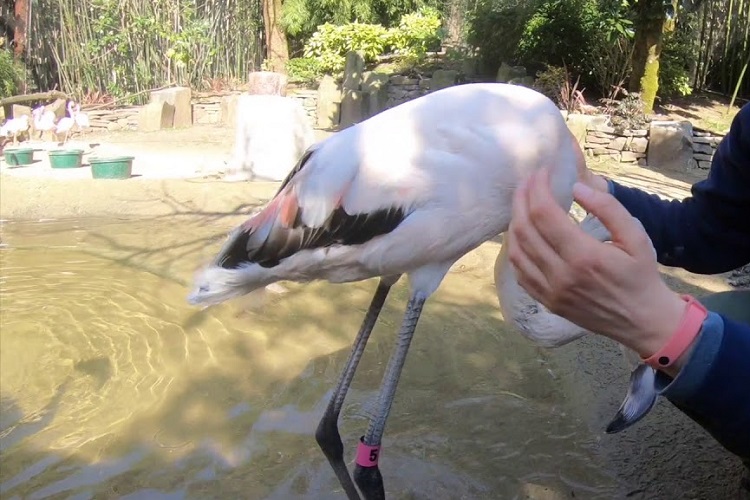
Many zoos keep flamingos and allow visitors to feed them by hand. These birds are so used to people, that they will happily take a snack from the palm of your hand. In some wildlife parks, the flamingos are free to wander around the grounds as they wish.
Flamingos that are bred and brought up in captivity are very comfortable with humans. With dedication, they can also be trained to follow simple commands and routines. If they spend a lot of time with a human, they form strong bonds that last for a lifetime.
Wild flamingos are rarely aggressive toward people, but you shouldn’t approach them. They are naturally afraid of people and may attack if they feel you pose a danger to them.
Conclusion
I think flamingos are superstars of the marine bird world. Not only do they have a bright and flamboyant appearance, but they also make a living in some of the most barren places on Earth.
A shallow, salty lake amongst some mud flats is inhospitable to most creatures, but not flamingos! These fancy birds are uniquely designed to scoop up and filter out their food from the saline waters (and look absolutely fabulous doing so).
I like how they keep experts guessing, too. No one knows for sure why flamingos stand on one leg. Maybe they do it just to stay mysterious? What do you think? Let us know in the comments b


